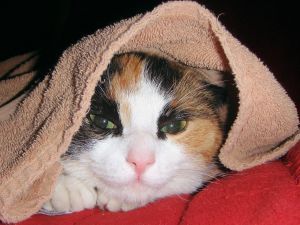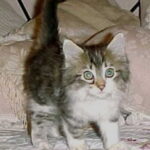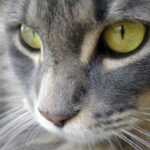Samantha stepped over a pile on the floor, annoyed to have another mess to clean up. The vet had told her that with five cats, she shouldn’t be surprised to find at least one regurgitated pile on the floor each week. However, this was the third day in a row. The following week, she got a quick education on the causes of esophagitis in cats when the vet diagnosed Jeffrey, her furry Maine Coon, with it.
What exactly is esophagitis?
PetMD refers to this condition as an inflammation of a cat’s esophagus. The most common cause of esophagitis is gastrointestinal reflux, also called acid reflux.
Regurgitation is one of the most frequent signs of this condition. In addition to vomiting, many cats go through extra motions with their heads and throats or appear to have increased amounts of saliva.
Pain during or after swallowing can make pets cry out in pain. Some cats have a poor appetite, are wary of moving or lying down, cough or have a fever. Weight loss is common. In some cases, the cat is simply unable to ingest food. If food particles lodge in the wrong place, pneumonia can develop.
Causes
Veterinarians make a diagnosis of esophagitis in cats only after taking a medical history and getting information from the owner regarding about the pet’s symptoms. They then conduct a physical exam and order standard lab tests such as blood chemistry and urinalysis. For some animals, the vet might also need to see the results of X-rays, ultrasound studies or barium contrast imaging.
There are a number of causes and risk factors linked to the inflammation:
Vomiting. Cats that throw up a lot are simply at higher risk for inflammation of the esophagus. A cat often vomits anything and everything in his or her stomach when trying to expel a hairball.
Reflux. This occurs with contents from the cat’s stomach or intestines flow backward toward the mouth. This creates irritation in the esophagus.
Swallowing foreign bodies. This includes a wide range of objects. Typical are hair, pennies, buttons, parts of pens, chicken bones and pieces of toys. Some cats are in love with the elastics or rubber bands used on ponytails.
Caustic substances. The range of possibilities is extensive. Insecticides, laundry chemicals and lawn and garden products are just a few.
Medication. Some cats seem to have difficulty swallowing pills, just as some humans do. A pill or capsule sometimes gets stuck in the esophagus without making it to the animal’s stomach.
Other illnesses. PetPlace.com reports that cancer in the esophagus and the presence of a hiatal hernia can cause esophagitis in cats. Some young cats born with a congenital structural abnormality of the esophagus are at high risk for this condition.
Surgery. A cat often develops an inflammation after the passing of a feeding tube down its throat. Use of a general anesthesia can sometimes cause reflux.
Fortunately, unless a cat develops pneumonia, treatment almost always occurs on an outpatient basis. Vets typically use gastric acid inhibitors or blocking agents, esophageal and gastric coating drugs as well as gastrointestinal mobility modifiers to tackle the inflammation. Sometimes surgery is necessary to remove a foreign object.
Home care depends on the cause or causes of the cat’s esophagitis . It typically includes changes in diet, avoiding late-night feedings and blocking access to any foreign objects or toxic products.
Sources:
PetMD site
PetPlace.com site
Reference:
- PetMD site
- PetPlace.com site







